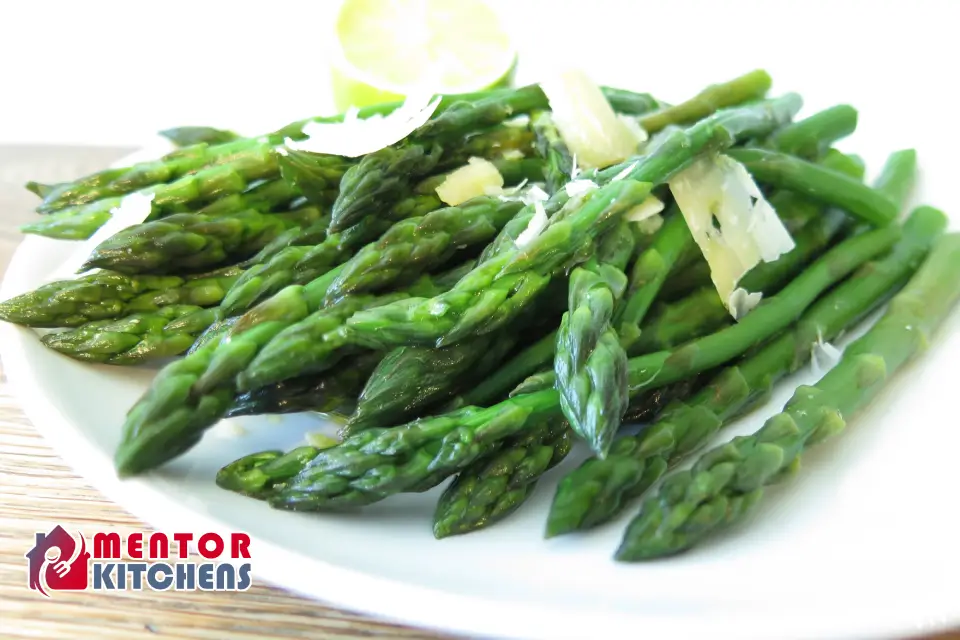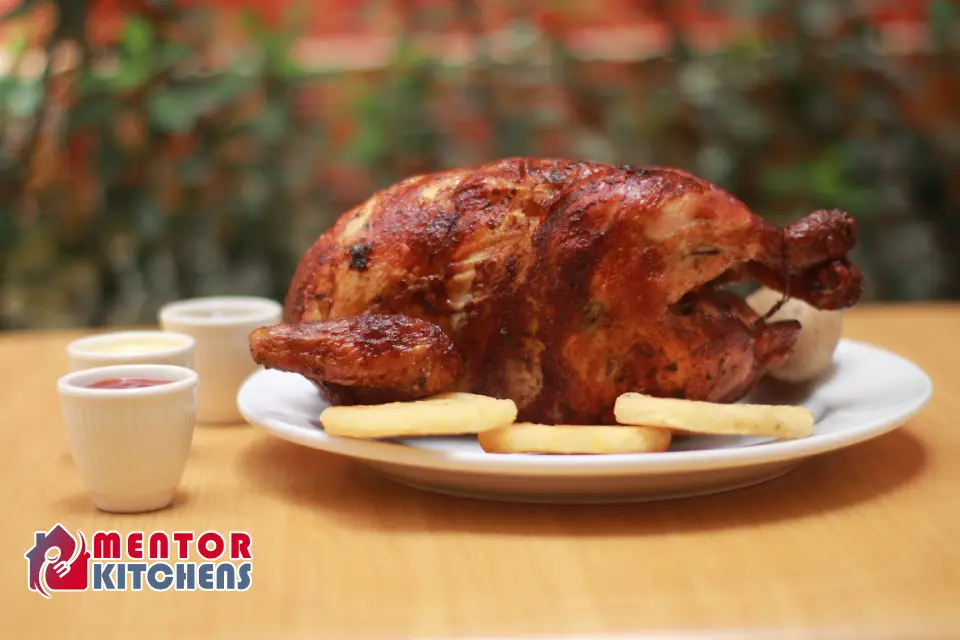Microwave cooking has gained immense popularity in recent years due to its convenience and time-saving benefits. One particular culinary delight that can be easily prepared in the microwave is asparagus.
Steaming asparagus in the microwave not only saves precious minutes in the kitchen but also retains its nutritional value, vibrant color, and delicate flavor.
In this comprehensive guide, we will explore the proper method to steam asparagus in the microwave, ensuring flawless results every time.
Why Steaming Asparagus in the Microwave?

Steaming asparagus in the microwave offers several advantages that make it the ideal cooking method for this delicious vegetable.
Maintaining Nutritional Value: Microwaving preserves the essential vitamins and minerals present in asparagus, ensuring that you receive maximum nutritional benefits from this healthy vegetable.
Retaining Vibrant Color and Texture: Unlike other cooking methods that may cause asparagus to become dull and limp, steaming in the microwave helps retain the freshness, vibrant green color, and crisp texture of the asparagus stalks.
Preserving Delicate Flavor: By steaming asparagus gently in the microwave, you can preserve its delicate flavor, allowing you to savor the natural taste without overwhelming it with excessive seasoning or cooking it for too long.
Choosing the Right Asparagus
Before embarking on the steaming process, it is important to select the right asparagus to ensure optimal results.
Selecting the Correct Thickness: Look for asparagus with a thickness that is neither too thin nor too thick. Thin stalks may become overcooked, while thick ones might be undercooked or have a fibrous texture.
Checking for Freshness and Quality: Choose asparagus with firm, crisp stalks, and tightly closed tips. Avoid those with visible signs of wilting, browning, or sliminess, as these may indicate a lack of freshness.
Organic vs. Conventional Options: If possible, opt for organic asparagus to minimize exposure to pesticides and enjoy a more environmentally conscious dining experience. However, conventional asparagus can also be used as long as it meets the quality and freshness criteria.
Gathering the Required Tools and Ingredients
To successfully steam asparagus in the microwave, gather the following tools and ingredients:
Microwave-safe Steaming Dish: Ensure you have a microwave-safe dish that is large enough to accommodate the asparagus while allowing for even heat distribution.
Asparagus Bunch: Purchase a fresh bunch of asparagus with the desired quantity for your meal or recipe.
Water: You will need water to create steam and provide moisture during the cooking process.
Salt and Pepper (Optional): If desired, have salt and pepper ready to season the steamed asparagus according to your taste preferences.
Preparing the Asparagus
Before steaming, it is essential to prepare the asparagus properly to remove any dirt or tough parts.
Washing the Asparagus: Rinse the asparagus under cold water to remove any dirt or impurities that may be present on the stalks.
Trimming the Tough Ends: Using a sharp knife or your hands, snap off the woody ends of the asparagus. The point at which the stalk naturally snaps is usually where the tough, fibrous part ends.
Optionally Peeling the Woody Stalk: If desired, you can use a vegetable peeler to gently remove the tough outer layer of the lower part of the asparagus stalk. This step is particularly useful for older, thicker stalks that might have a more fibrous texture.
Selecting the Ideal Microwave Dish
Choosing the right microwave dish is crucial for ensuring proper steaming of asparagus.
The Importance of Proper Size: Select a dish that allows the asparagus to lay flat without overlapping, ensuring even cooking throughout.
Choosing Materials – Glass, Ceramic, or Plastic: Opt for a microwave-safe dish made of either glass, ceramic, or certain microwave-safe plastics. Avoid using metal or dishes with metal accents, as they can cause sparks in the microwave.
Adding Water and Asparagus to the Dish
Before placing the asparagus in the microwave dish, it is necessary to add an appropriate amount of water.
Determining the Right Amount of Water: Pour enough water into the microwave dish to cover the bottom but not submerge the asparagus entirely. This helps create steam for the cooking process without overly saturating the vegetable.
Placing the Asparagus Uniformly: Arrange the trimmed asparagus in a single layer in the dish to ensure uniform steam distribution and consistent cooking.
Seasoning the Asparagus
While the natural flavor of asparagus is delightful on its own, adding seasonings can elevate its taste profile.
Enhancing Flavor with Salt and Pepper: Sprinkle salt and pepper over the asparagus to add a simple yet delicious taste. Adjust the seasoning according to your preferences.
Experimenting with Other Seasonings and Herbs: If you’re feeling adventurous, try incorporating other seasonings such as garlic powder, lemon zest, or your favorite herbs like thyme or rosemary. These additions can further enhance the flavor of steamed asparagus.
Covering the Dish Appropriately
To trap steam and ensure efficient cooking, it is important to cover the microwave dish properly.
Covering with Microwave-safe Lid: Use a microwave-safe lid that fits the dish to cover it securely. This traps the steam, allowing it to circulate around the asparagus for even cooking.
Alternatives to Using a Lid – Plastic Wrap or Microwave-safe Paper Towel: If you don’t have a lid that fits your dish, you can tightly cover it with microwave-safe plastic wrap, leaving a small vent for steam to escape. Alternatively, place a microwave-safe paper towel over the dish and secure it with a microwave-safe rubber band, again allowing steam to escape.
Microwaving the Asparagus
Proper microwaving is essential to achieve perfectly steamed asparagus.
Power and Time Settings for Different Microwave Wattages: Microwave wattages can vary, so adjusting the power and cooking time accordingly is important. As a starting point, microwave the asparagus on HIGH power for 2-4 minutes, depending on the wattage of your microwave.
Determining the Correct Cooking Time: Check the asparagus halfway through the cooking time. The cooking process can vary based on the thickness of the asparagus stalks and your personal preference for tenderness. Continue microwaving in short intervals until the desired doneness is reached.
Monitoring the Asparagus During Cooking: Keep an eye on the asparagus while it’s cooking to ensure it doesn’t overcook or become too soft. Adjust the cooking time as needed to achieve the desired texture.
Steaming Techniques for Tender Asparagus
To ensure even cooking and tender asparagus, employ the following techniques:
Ensuring Even Cooking with Frequent Turning: If you are cooking a large quantity of asparagus or using a smaller microwave, it is recommended to turn the asparagus halfway through the cooking process. This helps distribute heat more evenly, resulting in uniformly cooked stalks.
The Importance of Periodic Moisture Checking: As the asparagus steams in the microwave, periodically check for moisture levels. If the dish seems dry and the asparagus is not tender yet, you may need to add a small amount of water. This prevents the asparagus from drying out and becoming tough.
Testing Asparagus Doneness
Determining the doneness of steamed asparagus can be done through visual cues and gentle bending.
Visual Cues – Vibrant Color and Crispness: Steamed asparagus should have a vibrant green color and maintain a crisp texture. If it appears dull or overly soft, it may be overcooked.
Gentle Bending to Check Flexibility: Take a stalk of steamed asparagus and gently bend it. It should be flexible without snapping or becoming too limp. If it retains some firmness while bending, it is cooked to perfection.
Removing and Serving the Steamed Asparagus
Once the asparagus is steamed to perfection, it’s time to remove it from the microwave dish and serve it elegantly.
Properly Draining Excess Water: If there is excess water in the dish after steaming, carefully tilt or drain it, ensuring that the asparagus remains intact and doesn’t spill.
Plating Suggestions and Garnishing Ideas: Transfer the steamed asparagus to a serving platter or individual plates. Consider garnishing with a drizzle of olive oil, a sprinkle of grated Parmesan cheese, or a wedge of lemon to add an extra touch of flavor and presentation.
Storing Leftover Steamed Asparagus
If you have any steamed asparagus leftover, you can store it for future use.
Refrigerating for Short-term Use: To keep steamed asparagus fresh for a few days, transfer it to an airtight container or wrap it tightly in plastic wrap. Store it in the refrigerator, where it can stay fresh for up to three days.
Freezing for Long-term Storage: If you wish to store steamed asparagus for an extended period, blanch it quickly in boiling water for a minute, then transfer it to an airtight freezer-safe container or freezer bag. Properly sealed, steamed asparagus can remain in the freezer for up to six months.
Reheating Steamed Asparagus in the Microwave
When ready to enjoy your leftover steamed asparagus, follow these steps to regain its optimal texture and flavor.
Regaining Optimal Texture and Flavor: Place the desired amount of steamed asparagus on a microwave-safe dish, cover it loosely with a damp paper towel, and microwave on HIGH for 30-second intervals until the desired warmth is achieved. Avoid overcooking, as this can result in mushy asparagus.
Best Practices for Reheating: To prevent the asparagus from drying out, avoid overheating or microwaving for prolonged periods. Remember to check the asparagus frequently during reheating to prevent any potential loss of quality.
Tips and Tricks for Perfect Microwave Steamed Asparagus
Consider the following tips and tricks to enhance your microwave-steamed asparagus experience:
Preparing Multiple Asparagus Batches: If you have a large quantity of asparagus to steam, it may be more efficient to steam it in smaller batches rather than overcrowding the microwave dish. This ensures proper heat distribution and uniform cooking.
Adjusting Cooking Time for Personal Preferences: The recommended cooking times are a general guide. Adjust the cooking time according to your personal preference for asparagus tenderness. Cook for shorter durations for crisper asparagus or longer durations for a softer texture.
Common Mistakes to Avoid
Steaming asparagus in the microwave is a relatively simple process, but it’s important to steer clear of common pitfalls.
Overcooking the Asparagus: Overcooking can result in mushy asparagus with a loss of flavor and vibrant color. Monitor the cooking process closely and ensure you remove the asparagus from the microwave at just the right moment.
Undercooking and Serving Raw Asparagus: Undercooking can leave the asparagus too tough and fibrous, making it difficult to chew. Aim for a balance of tenderness and crispness, adjusting cooking time accordingly.
Health Benefits of Asparagus Steaming
Steaming asparagus in the microwave not only offers culinary advantages but also provides numerous health benefits.
High Fiber Content and Digestive Benefits: Asparagus is rich in dietary fiber, aiding in digestion and promoting a healthy digestive system.
Essential Vitamins and Nutrients: Steaming preserves the vitamins and minerals inherent in asparagus, including vitamin K, folate, vitamin C, and various antioxidants. These nutrients contribute to overall health and well-being.
Summary
Mastering the proper method to steam asparagus in the microwave ensures excellent results every time. From selecting the ideal asparagus and gathering the necessary tools to properly season and microwaving the vegetable, there are several crucial steps to follow. By adhering to these guidelines, you can enjoy flawlessly steamed asparagus that retains its vibrant color, delicate flavor, and nutritional value.
Frequently Asked Questions:
To address common inquiries about microwave-steamed asparagus, here are some frequently asked questions and their answers.
Can I Steam Asparagus Without a Microwave-safe Dish?
It is not recommended to steam asparagus without a microwave-safe dish, as it may cause damage to your microwave or compromise your safety.
Is It Necessary to Peel Asparagus Before Steaming?
Peeling asparagus is optional, and the need for it depends on personal preference and the thickness of the stalks. Thicker, older asparagus stalks may benefit from peeling to remove fibrous parts.
How Do I Prevent Overcooking the Asparagus?
To avoid overcooking, monitor the asparagus closely and adjust the cooking time based on the desired tenderness. Remember that asparagus continues to cook even after being removed from the microwave due to residual heat.
Can I Steam Frozen Asparagus in the Microwave?
Frozen asparagus is not ideal for steaming in the microwave, as it may become excessively soft or watery. It is recommended to thaw frozen asparagus before steaming.
Are There Any Creative Serving Suggestions for Steamed Asparagus?
Steamed asparagus can be served plain, with a drizzle of olive oil, a sprinkle of grated cheese, or a squeeze of lemon juice. It can also be incorporated into salads, pastas, or served alongside grilled meats.
How Long Can I Store Leftover Steamed Asparagus?
Leftover steamed asparagus can be stored in the refrigerator for up to three days. If frozen, it can be stored for up to six months.
Can I Steam Other Vegetables Using the Same Technique?
Yes, the same steaming technique can be applied to various vegetables such as broccoli, cauliflower, carrots, and green beans. Adjust the cooking times based on the specific vegetable’s tenderness and texture.
What Are Some Alternative Methods to Steaming Asparagus?
Asparagus can also be roasted, grilled, or sautéed to achieve different flavor profiles and textures.
Is Microwave-steamed Asparagus Suitable for Specific Dietary Restrictions?
Microwave-steamed asparagus can be enjoyed by individuals following a variety of dietary restrictions, including vegetarian, vegan, gluten-free, and dairy-free diets.
Can I Use This Method for Wild Asparagus Varieties?
Yes, the method described in this guide can be used for both cultivated and wild asparagus varieties, ensuring delicious results.



Leave a Reply